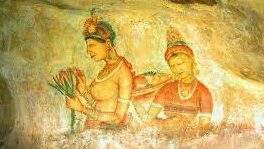The Untold Story of Sri Lanka’s Ancient Art Legacy
Art in Sri Lanka is not merely an aesthetic pursuit but a mirror of civilization, philosophy and resilience. Long before colonial painters touched the island’s shores and centuries before recorded history, Sri Lanka’s artistic spirit had already taken shape in cave walls, terracotta carvings and religious architecture. Yet for many outside scholars, Sri Lankan art begins and ends with the Sigiriya frescoes, those enigmatic celestial maidens floating on the rock fortress. The story, however, runs much deeper. The true legacy of Sri Lankan art is a narrative of cultural synthesis, spiritual symbolism and mastery of material long forgotten by time.
The Sigiriya frescoes, painted in the 5th century during the reign of King Kashyapa, are widely celebrated as masterpieces of ancient Southeast Asian art. Their technique, using natural pigments and a tempera-like method to bind color into rock, was far ahead of its time. But Sigiriya did not appear out of nowhere. It was built upon a long lineage of prehistoric artistic traditions. At sites like Fa Hien Cave and Batadomba Lena, archaeologists have found tools and symbolic carvings dating back over 30,000 years, suggesting that even Sri Lanka’s earliest inhabitants had a visual language rooted in ritual and identity.
While much of South Asian religious art was influenced by invasions or dynastic change, Sri Lanka developed an uninterrupted Buddhist art tradition after the introduction of Buddhism in the 3rd century BCE. The island became a sanctuary of Theravāda thought, and this spiritual foundation deeply informed its artistic evolution. Structures like the Thuparamaya and Ruwanwelisaya in Anuradhapura are not mere religious monuments, they are symmetrical precision engineered in stone. The stupas, often mistaken as simple domes by outsiders, were cosmological blueprints representing the universe, enlightenment and the eternal journey of existence.
As civilization moved south to Polonnaruwa in the 11th and 12th centuries, a new visual philosophy emerged, one that blended emotion with monumental scale. The Gal Viharaya sculptures stand as a testament to this era. Carved from a single granite rock face, the serene meditating Buddha and the towering standing figure display emotional depth rarely seen in Buddhist sculpture across Asia. Scholars still debate whether the standing statue expresses compassion or grief, a mystery that only adds to its aura.
Although Sri Lankan art absorbed influences from India, Southeast Asia and later Portugal and the Netherlands, it never lost its indigenous identity. Even during colonial periods, artistic heritage persisted, often coded into traditional temple murals and village rituals. The vibrant paintings at temples like Dambulla, Degaldoruwa and Lankatilaka fuse narrative illustration with religious symbolism. They are not merely devotional, they are historical archives painted in natural hues of crushed stone and herbal dyes. These painters were not named, not celebrated, yet they preserved a visual lineage that survived war, drought and colonization.
Today, Sri Lanka’s ancient art stands at a crossroads. Much of it is fading under humidity, pollution and neglect. Tourist traffic threatens sacred wall paintings. Commercialization risks stripping meaning from traditional art forms. But there is a growing movement within the country, among historians, conservationists and young artists, to reclaim this heritage. Ancient Sri Lankan art does not belong behind museum glass. It is a living inheritance, one that continues to shape identity and offer a reminder of a time when art was not separate from life, but a path to understanding it.




